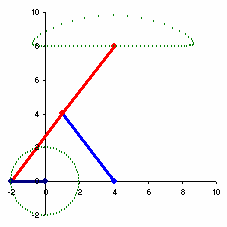3-Position Motion Generation Synthesis with Alternate Moving Pivots using Unigraphics NX4 Sketch
In the previous post [3-Position Motion Generation Four-Bar Linkage Synthesis using Unigraphics NX4 Sketch], the locations of fixed pivots O2 and O4 are fixed due to the fixed locations of moving pivots A and B. Sometimes, the location of O2 and O4 are undesirable with respect to your design constraints. More flexible method to get desirable locations of O2 and O4 will be shown in this post.
1) Draw link AB in its three design positions A1B1, A2B2, and A3B3 as shown above.
7) Bisect line D1D2 and line D2D3 and extend their perpendicular bisectors until they intersect with each other. Label the intersection O4.
8) Draw line O4D1. It's link 4.
9) Draw line O2M and set the same length as O2C1.
10) Draw line O4N and set the same length as O4D1.
11) Draw line MN and set the same length as C1D1. Do the same for remaining lines, set constraint so that it form the same rigid link as ABDC.
12) Set angular dimension between O4D1 and O4N to any desired value e.g. 20 degrees.
13) Select "Animate Dimension" Command in Unigraphics NX4 sketch and set lower limt to 0 and Upper limit to 60 (or any other value) and Steps/Cycle to 150 (the more steps, the smoother simulation).
See the results of four-bar linkage from three-position motion generation synthesis with alternate moving pivots in the following video clip.
Further reading:
1) Draw link AB in its three design positions A1B1, A2B2, and A3B3 as shown above.
2) Draw new attachment points C1 and D1 and other lines to form the rigid link ABDC. Do the same for position 2 and 3. Use "Constraint" command in Unigraphics NX4 sketch to set the equal length constraint to all relevant lines e.g. A1C1, A2C2, and A3C3 have the same length, but don't need to specify the fixed value for it. Once we complete these settings at all positions, it means we have set the fixed relationship between our desired line AB and other moving pivots CD.
3) Draw construction lines from point C1 to C2 and C2 to C3
4) Bisect line C1C2 and line C2C2 and extend their perpendicular bisectors until they intersect with each other. Label the intersection O2.
5) Draw line O2C1. It's link 2.
6) Repeat the same for another end of the link. Draw construction lines from point D1 to D2 and D2 to D3
7) Bisect line D1D2 and line D2D3 and extend their perpendicular bisectors until they intersect with each other. Label the intersection O4.
8) Draw line O4D1. It's link 4.
9) Draw line O2M and set the same length as O2C1.
10) Draw line O4N and set the same length as O4D1.
11) Draw line MN and set the same length as C1D1. Do the same for remaining lines, set constraint so that it form the same rigid link as ABDC.
12) Set angular dimension between O4D1 and O4N to any desired value e.g. 20 degrees.
13) Select "Animate Dimension" Command in Unigraphics NX4 sketch and set lower limt to 0 and Upper limit to 60 (or any other value) and Steps/Cycle to 150 (the more steps, the smoother simulation).
See the results of four-bar linkage from three-position motion generation synthesis with alternate moving pivots in the following video clip.
Further reading:
- Design of Machinery with Student Resource DVD
- Design of Machinery (Mcgraw-Hill Series in Mechanical Engineering)
- Design of Machinery: An Introduction to the Synthesis and Analysis of Mechanisms and Machines
- Machine Design: An Integrated Approach (3rd Edition)
- Kinematics, Dynamics, and Design of Machinery
- The Mechanical Design Process (Mcgraw-Hill Series in Mechanical Engineering)









Comments